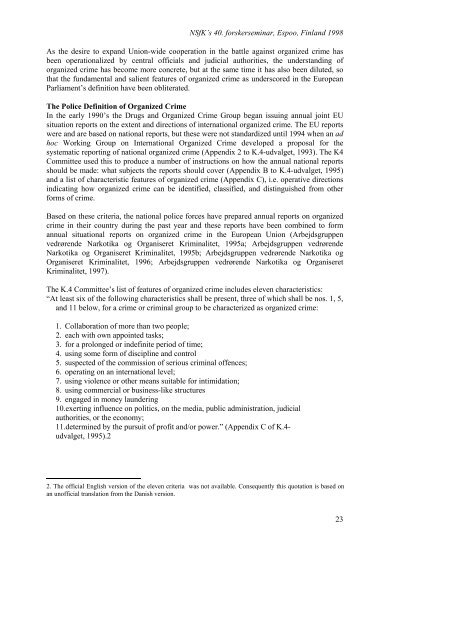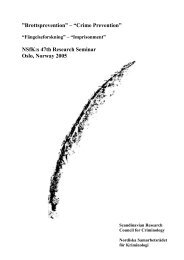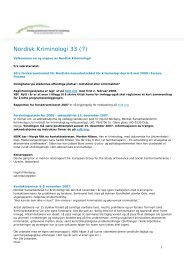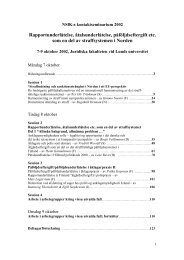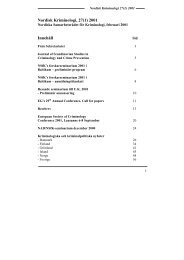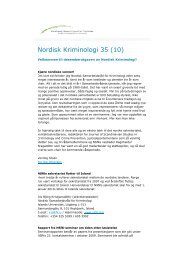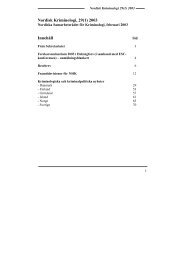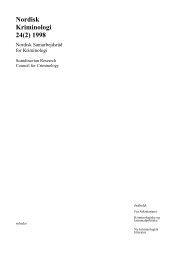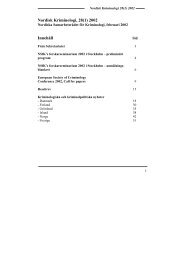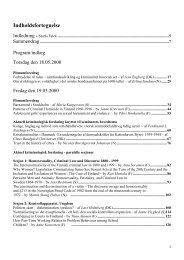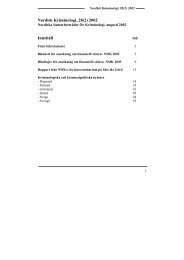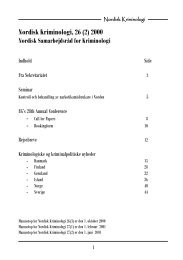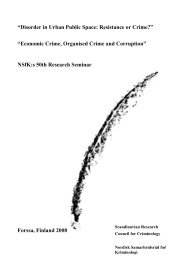Organised Crime & Crime Prevention - what works? - Scandinavian ...
Organised Crime & Crime Prevention - what works? - Scandinavian ...
Organised Crime & Crime Prevention - what works? - Scandinavian ...
Create successful ePaper yourself
Turn your PDF publications into a flip-book with our unique Google optimized e-Paper software.
NSfK’s 40. forskerseminar, Espoo, Finland 1998<br />
As the desire to expand Union-wide cooperation in the battle against organized crime has<br />
been operationalized by central officials and judicial authorities, the understanding of<br />
organized crime has become more concrete, but at the same time it has also been diluted, so<br />
that the fundamental and salient features of organized crime as underscored in the European<br />
Parliament’s definition have been obliterated.<br />
The Police Definition of Organized <strong>Crime</strong><br />
In the early 1990’s the Drugs and Organized <strong>Crime</strong> Group began issuing annual joint EU<br />
situation reports on the extent and directions of international organized crime. The EU reports<br />
were and are based on national reports, but these were not standardized until 1994 when an ad<br />
hoc Working Group on International Organized <strong>Crime</strong> developed a proposal for the<br />
systematic reporting of national organized crime (Appendix 2 to K.4-udvalget, 1993). The K4<br />
Committee used this to produce a number of instructions on how the annual national reports<br />
should be made: <strong>what</strong> subjects the reports should cover (Appendix B to K.4-udvalget, 1995)<br />
and a list of characteristic features of organized crime (Appendix C), i.e. operative directions<br />
indicating how organized crime can be identified, classified, and distinguished from other<br />
forms of crime.<br />
Based on these criteria, the national police forces have prepared annual reports on organized<br />
crime in their country during the past year and these reports have been combined to form<br />
annual situational reports on organized crime in the European Union (Arbejdsgruppen<br />
vedrørende Narkotika og Organiseret Kriminalitet, 1995a; Arbejdsgruppen vedrørende<br />
Narkotika og Organiseret Kriminalitet, 1995b; Arbejdsgruppen vedrørende Narkotika og<br />
Organiseret Kriminalitet, 1996; Arbejdsgruppen vedrørende Narkotika og Organiseret<br />
Kriminalitet, 1997).<br />
The K.4 Committee’s list of features of organized crime includes eleven characteristics:<br />
“At least six of the following characteristics shall be present, three of which shall be nos. 1, 5,<br />
and 11 below, for a crime or criminal group to be characterized as organized crime:<br />
1. Collaboration of more than two people;<br />
2. each with own appointed tasks;<br />
3. for a prolonged or indefinite period of time;<br />
4. using some form of discipline and control<br />
5. suspected of the commission of serious criminal offences;<br />
6. operating on an international level;<br />
7. using violence or other means suitable for intimidation;<br />
8. using commercial or business-like structures<br />
9. engaged in money laundering<br />
10.exerting influence on politics, on the media, public administration, judicial<br />
authorities, or the economy;<br />
11.determined by the pursuit of profit and/or power.” (Appendix C of K.4-<br />
udvalget, 1995).2<br />
2. The official English version of the eleven criteria was not available. Consequently this quotation is based on<br />
an unofficial translation from the Danish version.<br />
23


